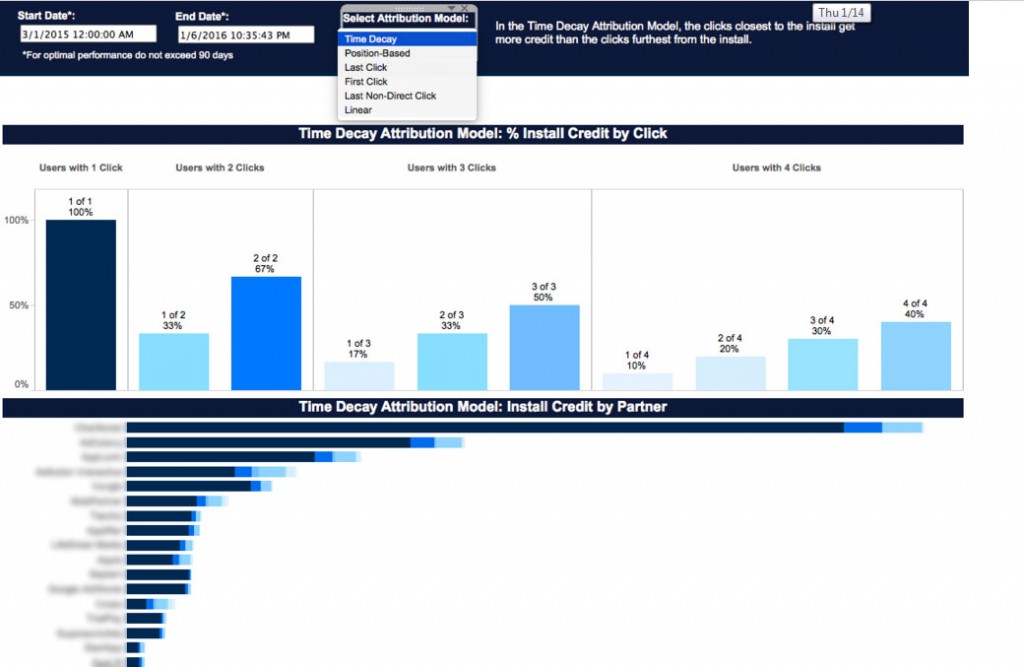Top app marketers spend multiple millions per month on acquiring new users. Even smaller companies are often shelling out $30,000 to $40,000 every month to feed their growth engines. There’s only one problem: many don’t know exactly what they’re paying for.
“The mobile ecosystem is largely dependent on the last click model,” TUNE business intelligence manager Ameer Hashish told me today. “But it’s a complex interdependent system, with multiple ad networks drawing on each other’s inventory.”

Example attribution modeling. Ad partners’ names are blurred for privacy.
The Result
The result is that most ad-driven app installs are influenced by many ads and multiple clicks — often as many as five or seven. That’s not just due to ad inventory sharing; it’s also mobile user psychology. The first time you see something, you might ignore it. The second, you’re intrigued. And the third, you might actually pursue it and “convert” … click on an ad, download an app, and try it out.
It’s not exactly changing your religion, but it is the holy grail for app marketers.
 The problem for app makers and advertising partners is simple: credit. As in all areas of life, success has a thousand fathers and failure is an orphan: most marketers use a simplistic last-click attribution model which over-credits the lucky last and under-credits the unfortunate leaders. Most ad networks, therefore, will see the install — particularly if they’re using a long 28-day attribution window — and enthusiastically claim ownership. Inevitably, billing challenges result as multiple ad networks try to take credit for a single install, and marketers try to understand the situation.
The problem for app makers and advertising partners is simple: credit. As in all areas of life, success has a thousand fathers and failure is an orphan: most marketers use a simplistic last-click attribution model which over-credits the lucky last and under-credits the unfortunate leaders. Most ad networks, therefore, will see the install — particularly if they’re using a long 28-day attribution window — and enthusiastically claim ownership. Inevitably, billing challenges result as multiple ad networks try to take credit for a single install, and marketers try to understand the situation.
There is of course one virtue to last-click attribution: it’s easy. So easy that it’s overused to the point that some marketers are asking when it will finally die, since it only tells you only a fraction of the real story.
The Solution
The obvious solution is multi-touch attribution, which acknowledges each ad partner’s assistance in the ultimate goal, and fairly compensates their efforts while not over-charging the app marketer.
The challenges, however, remain:
- How do you monitor and manage multitouch attribution?
- How do you decide on an exact model?
“There are many different models… weighted attribution, where the first click might get 25%, the last click 50%; time-based, where ads only get credit if the install occurs within three days, for instance; linear attribution, where every click gets equal credit, and more,” says Hashish. “App marketers are looking for the sweet spot — the highest number of installs at the lowest cost — and you find it by adjusting the variables.”
That’s in fact what the TUNE business intelligence team has built: a way to model different attribution models in which marketers can adjust exactly how much credit is given for different factors, and show publishers how their costs and return will change as they fine-tune attribution.
The results are significant: “We’ve seen up to a 30-40% decrease in cost when you apply these models,” says Hashish.
Like this article? Sign up for our blog digest emails.
Author
Before acting as a mobile economist for TUNE, John built the VB Insight research team at VentureBeat and managed teams creating software for partners like Intel and Disney. In addition, he led technical teams, built social sites and mobile apps, and consulted on mobile, social, and IoT. In 2014, he was named to Folio's top 100 of the media industry's "most innovative entrepreneurs and market shaker-uppers." John lives in British Columbia, Canada with his family, where he coaches baseball and hockey, though not at the same time.




Well-explained. But missing the crucial point: the cost savings is not due to just to having a weighted attribution model, but rather by being able to convince ad partners to accept the model **and associated bounty amounts for each touchpoint level**.
If the advertiser sets a $10 total bounty, whether it’s paid 100% to the last-click publisher, or spread out using some formula over 10 publishers that touched the buyer, it’s still $10 out the door. Only by changing the **total** bounty can you reduce costs.
Of course, if you set $10 and are actually paying $13 because of competing, overlapping claims, then getting the collective set of referrers to agree to $10 will save money. But either way, it’s all about convincing your referrers to accept your algorithm. As the article *title* states, “top app marketers” likely have the leverage to do this. Little guys, not so much.
The solution — or at least the attempt at a solution: Try to get your publishers to agree to a formula, based on transparent, authoritative data from your analytics program. For each referrer, show them how many bounties they got at 1st touch, 2nd touch, etc., along with corresponding bounty $ amounts at each touchpoint. Simple math, but looks legit and may get them to say OK.
You’re right mark. The model of compensating on multi-touch is complicated. This has always been one of the major things holding back a true MTA model, especially when the really large adtech companies like Google and Facebook are unlikely to participate in any advertiser’s model.
What gets me most excited about the future of multi-touch is the end of de-duplication discrepancies. All impressions, clicks, visits, installs, etc. are considered in a multi-touch model, and whoever is reading the data can determine how much each touchpoint is worth based on timing. So in the end, the publisher will always get credit for everything they provide. It will only be a question of how valuable their contribution was.